Nanotechnology Island has launched in Second Life with the goal to establish a place for the Nano Science and Technology communities to come together and to bring key ideas and research into public discussion.
Nanoscience and technology like virtual worlds are frequently cited as “disruptive†technologies. These fields should evolve in relationships between scientists, engineers, policymakers and regulators in a global setting with the opportunity for public debate and engagement.
Nanotechnology is a term used to describe the manipulation of materials at a nanometer of scale – a nanometer is a billionth of a meter. Chris Ewels explains: “This is the scale of large molecules; molecular chains (like plastics), proteins (from biology), nano-crystals (for example nanocrystalline diamond) and new large molecules like fullerenes and nanotubes.” See his site for more info and many wonderful pictures including the picture above from his gallery fantastic.
While nanoscience is rooted in the physics and chemistry of objects at the nanoscale, it involves a broad collection of technologies and scientific research — from diverse fields such as physics, materials science, engineering, chemistry, biochemistry, bio-engineering, medicine, optics and more.
Shifts in thinking and technology emerging from nanotechnology have big implications for our future and may lead to the end of the age of industrial design, production and consumption (see the seminal book on nanotechnology Engines Of Creation by K. Eric Drexler).
Creating a community of communities in SL
The communities of nanotechnology and science are dispersed across disciplines and geography. This Second Life project aims to “create an exemplar for using SL as a community aggregator (community of communities).â€
Nanotechnology Island is based in the multidisciplinary SciLands in Second Life. SciLands is an international cross-disciplinary community, currently numbering 34 islands, with its own orientation island and regular events. This is an ideal location for Nanotechnology Island to begin to encourage inter and intra-community dialogue and give an opportunity for many people to play a role in envisioning and defining the future.
Dave Taylor, of the National Physical Laboratory (in the UK), explains that some of the key objectives are to:
provide resources to nanotechnology-related individuals and organizations to help them get started in SL: mentoring, technical help, access to shared land and facilities, and subsidised SL development. This last part means that NPL will help cover the costs of developers for SL projects that are approved for display on Nanotechnology island.
Dave then added more specifics about the services that would be made available:
1) Free assistance with Second Life basics for Nanotechnology subject specialists new to Second Life. Nanotechnology Subject Specialists attending meetings can use the SciLands orientation zone and meet with our representatives in Second Life to learn about the basics (e.g. how to move around, how to communicate and give presentations, how to change your appearance, how to search, how to find more help).
2) Free assistance with preparing, promoting and supporting suitable events on Nanotechnology Island.
3) Free space (land) on Nanotechnology Island to host displays or exhibits relating to nanotechnology.
4) Funding to help build (develop) an exhibit or display to be shown on Nanotechnology Island. Note: some simple exhibits (e.g. posters or simple molecular models) can be made for free.
Nanotechnology and the OS for Spaceship Earth
In an earlier post, I discussed the role that online, immersive, collaborative 3D virtual environments like Second Life will play in creating the operating systems for planet earth. Buckminster Fuller, whose visions reemerge in nanotechnology, makes a call for human cooperation in creating a future in the final words of his book, “Operating System for Spaceship Earth,†1963.
The phrase Spaceship Earth brilliantly suggests the relationships on a galactic scale that nanotechnology both emerged from and can be extrapolated to. And Buckminster Fullers’s operating system for spaceship earth foreshadows not only ideas of “self-assembly†that emerge from nanotechnology but the notion of virtual operations centers emerging from the collaborative networked intelligence of virtual worlds. See my earlier posts, here, here and here to learn more about Eolus One and other projects that are beginning to develop Virtual Operations Centers in Second Life for energy monitoring, environmental management, health care and more.
I was kindly given permission to use this picture and the picture opening this post by Dr Chris Ewel, Research Fellow at the Institute of Materials, Nantes where he models impurities and defects in nanostructures, and EELS microscopy of new nanomaterials. They are from his gallery fantastic. Ewels calls the one above “Dreams of Buckminster Fuller.â€
Buckminster Fuller structures are reappearing in the chemistry of the nanoscale. And, as Ewels points out, Buckminster Fuller once designed a geodesic dome large enough to cover mid-town Manhattan. . “So why not extrapolate a little?!â€
C60, the carbon molecule [known as the “bucky ball"] arguably started the whole nanoscience revolution in the eighties, was originally discovered by accident – by a group of scientists trying to understand the formation and behaviour of carbon molecules in interstellar gas clouds.
Extrapolation on an unprecendented scale is intrinsic to the nano revolution. For as much as nanotechnology is rooted in a precise notion of measurement at a very small scale, the implications of the discoveries are far reaching. The famous and controversial heart of nanoscience thinking is the possibility of “self- assembly.†“Self-assembly†is the fundamental principle which generates structural organization on many scales, from molecules to galaxies.
Nanotechnology presents the opportunity to go beyond what natural mechanisms currently allow by creating assembly systems that can build complex devices from elemental atoms or molecules.
The manipulation of matter on an atom-by-atom basis to create specific configurations for molecules, or “molecular manufacturingâ€, is probably at least a decade away from being used at commercial levels, but self-assembly systems are widely used in nature and have already been harnessed in scientific experiments.
As Nanotechnology matures, it will likely prove to be revolutionary in reversing a fundamental basis of human-based manufacturing.
To date, human manufacturing has been a top-down process taking larger materials and cutting and shaping them down into parts of products. Molecular manufacturing, on the other hand, starts with the building blocks of atoms and molecules and combines them to form objects from the bottom up. This is how nature has worked for billions of years. Eventually this approach may replace many of today’s production processes and find applications throughout society. (UCLA Journal of Law and Technology).
Chris Ewels noted when I asked him to comment:
nanotechnology works with both bottom-up and top-down and there’s lots of cool stuff being done with top-down.
Chris also pointed out that many of the ideas In Drexler’s book in his view are more science fiction than science fact:
(scientifically they just don’t work – if you’ve seen pictures of molecular cogs made from individual molecules, these ignore the fact that molecules tend to stick together, for example). For me the thing that nanotechnology does and will do well, is it allows us to do stuff that happens now, but better! So solar cells that are much more efficient, catalysts that work better, etc etc – not quite so glamorous but if you can make a solar cell 4 times more efficient then you can change the world!
One of the most exciting things about nanotechnology communities coming to Second Life will be that the ideas in nanotechnology that are about exploring the fundamental limits of human ingenuity – provocations to possible futures on the one hand; and on ground innovations from nano science and technology that are changing our world now on the other – will be integrated into the networked human intelligence of the virtual frontier. And this virtual frontier, exemplified by Second Life, is itself a new adventure in human imagination and possibility
A Tour of Nanotechnology Island on Second Life.
Two avatars operated simultaneously by Dave Taylor from the National Physical Laboratory showed me around Nanotechnology Island. ‘Davee Commerce’ is the avatar on the right and on the left is ‘Innovation Projects’ an official NPL avatar.
While the prime objective is to help others make exhibits there are some very interesting exhibits that have already been developed by NPL. The first one (pictured below) Davee Commerce showed me is a SIMS instrument. SIMS stands for Secondary Ion Mass Spectrometry – and is used to analyse complex structures.
Nearby are giant animated models with an explanatory display to explain SIMS – a process in which “you basically fire charged molecules or atoms at stuff and see what comes out.â€
I watched both an animation of a charged red bismuth ion and one of a “Buckyball,†striking a sample, developed for NPL by Troy McLuhan. Troy pointed out the red and yellow things that go flying are ions and they get pulled away for analysis. “It’s sort of like figuring out what the surface of a watch is made of by shooting it with a narrow-beam sandblaster and seeing what the sand knocks of.â€
Also in the exhibit is an AFM – Atomic Force Microscope that works by dragging a very narrow point (atomic sized) across a surface and watching the point go up and down (with a laser beam bounced off a reflector attached to the point). “Sort of like blind people reading braille,†Troy noted.
See the NPL website for more on AFM. DNA structural change and single molecule detections are key areas of AFM research. Carbon nanotubes are ideal tips for AFM because they can have diameters as small as one nanometer.
Davee Commerce took me on a flying tour of a carbon nanotube.
Single-walled carbon nanotubes are being used for investigating surface-protein and protein-protein binding and developing highly specific electronic biomolecule detectors.
Dave took me on a tour inside a single walled carbon nanotube and also explained the structure of DNA to me (image behind the nano tube above and detail below).
Nanotechnology Island includes several interesting buildings produced for NPL by NMC Virtual Worlds and an auditorium that will host regular nano-related events.
The center piece, The Tower of Ten, will house a series of exhibits that change scale by a factor of ten at each level all the way down to the nanolevel. The AFM and SIMS exhibits are housed in an a reproduction based on the architecture of the NPL building in the UK. The laboratories inside were modelled on some of those at NPL, but are typical of specialist nanotechnology centres around the world. Outside there is an animated reproduction of “Newtons Apple Tree.”
A tree grown from a graft from an old tree in Newton’s family garden in Woolsthorpe, near Grantham in Lincolnshire still drops apples outside the “real” life NPL building.
According to popular accounts, it was the fall of an apple from this tree that suggested to Newton that the force of gravity that caused the apple to drop to Earth was the same force that kept the moon on its path. The original tree was cared for until it was blown down in 1820 (“Notes and records of the Royal Society Vol 9″).
Playing With The Havoc 4 Physics Engine To Explore Nano Ideas in SL
Seeing Newton’s revered apple tree gave me an idea to ask some nano thinkers the question:
Can ideas of self assembly at least as concepts be explored on SL by playing with the physics engine – and could that be of value in communicating and understanding these concepts better and bringing the rapid prototyping and collaborative potential of the SL environment into nano thinking.
I gave this question to David Orban whose company Questar is in SL consulting, “but with our twists… No architectural building, but community creation, etc. ” David Orban is an entrepreneur interested in the Technological Singularity (see my earlier post) and Memetic Engineering. He is a member of the Singularity Institute, and is on the Advisory Board of the Lifeboat Foundation.
- We know how the world works in the macro-scale. That is why building real-scale stuff in SL in rather unexciting, at least to me. But we do not know well enough how stuff behaves on the nano-scale.
- And in SL, or other online worlds, we have the chance to simulate the world as we would perceive it if we were able to directly participate in them.
- We have to change the physics. For example: to us water is fluid but on the nanoscale it is not.
- The bipolar nature of the water molecule manifests itself, with the Van der Waals forces becoming very, very important. The surface of water becomes an almost impenetrable barrier.
- In my opinion, once again, it will be with the open-sourcing of the server that makes this kind of experiment.
- You have to change just a few parameters, and see the consequences. Let me give you an example:
- In the good old days of Virtual Reality 1.0 in the end of the eighties with VPL Research, Jaron Lanier, etc. the immersive RL was not fun to me as it was emulating reality.
- What I wanted to do is emulate irreality so for example change gravity, and learn to juggle then turn the gravity knob up little by little, and once I got to Earth gravity take off the goggles and juggle for real!
- I want to change just a few parameters as well, and learn from them. Right now the changes have to be programmed into each individual object, instead of being a feature of the background.
- They way to do it is to tweak the underlying Havoc engine which is the basis of the simulation calculating the collisions and what happens to objects as they clash at given speeds, at given characteristics, etc.
- For example, making stuff sticky: that is chemistry!
- Or making stuff blow up: that is nuclear reactions…
- Or model how the changing nature of mechanical resistance can help or hinder the building of self assembling structures.
I asked David Orban if he was willing to give me a cartoon to illustrate our conversation in skype. And he very gamely posted these two drawings to Flickr for me.
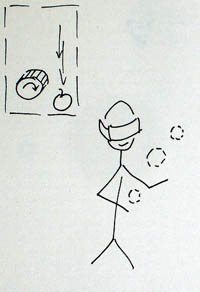
Start juggling with a low-gravity setting, and follow the balls with your conscious brain. Turn up…
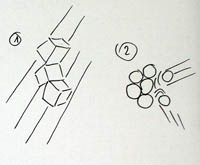
- Sticky objects simulate chemistry, and materials’ science.
-
But you can’t……..
But you can’t just tweak some parameters in the physics engine to simulate physics at the nanoscale. [this was Troy McLuhan's initial response to my question]. That’s fundamentally wrong. Quantum mechanics is NOT classical mechanics with some tweaked parameters. It’s qualitatively different?
I am sure that Troy is not alone in the scepticism he expressed to me on playing with the SL physics engine to explore nano ideas.
Early in my career I spent some time working on ways to represent time travel in film and for this we were constantly playing with ideas of light and motion through algorithms, lenses, and film printing technologies. Obviously this did not further the technology of time travel per se. But constantly pushing at the possibilities of time travel’s representation I believe enhances its possibility in human imagination and endeavor. So to me tweaking the physics engine of Second Life to explore the possibilities of nano thinking seems a logical next step. I asked David Orban if he could clarify further his ideas. He responded:
Quantum Mechanics is fundamentally different. But it is so much so that we have probably just no way of perceiving it in the ‘right’ way in any simulation just as we can’t in reality. We don’t even know what Quantum Mechanics means!
Playing with the havoc engine is just another way to play with an idea with cannot and never can see right!
Anyway: the realm of reality we perceive is one, that of the quantum is an other. Making that one visible is likely to be impossible.
But we can work around that. I think
We’ll see…if we don’t start from somewhere, and “tweak some parameters” we won’t get anywhere.

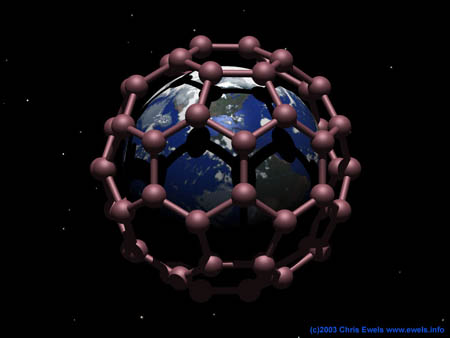
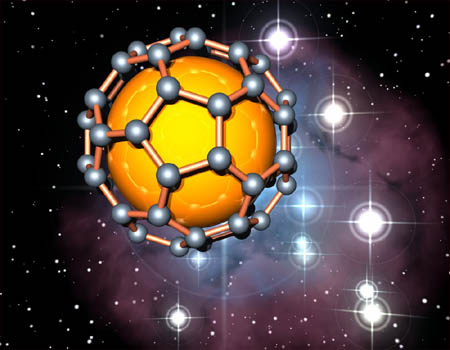
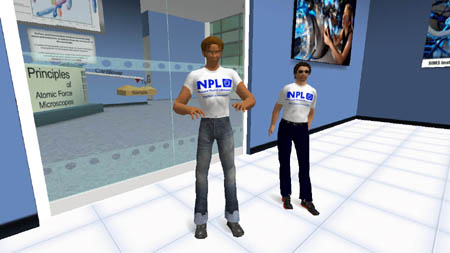
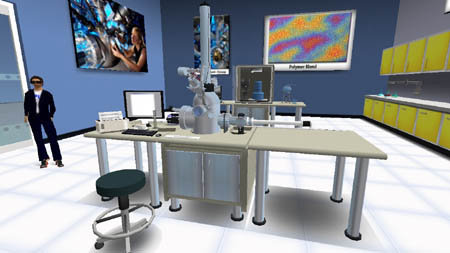
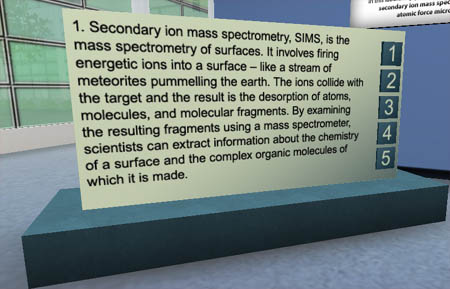
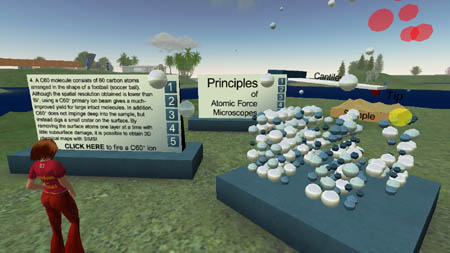
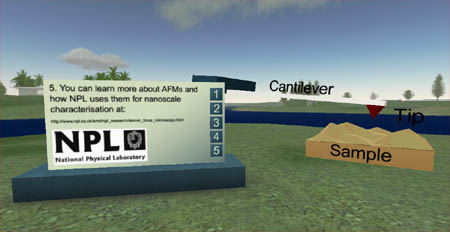
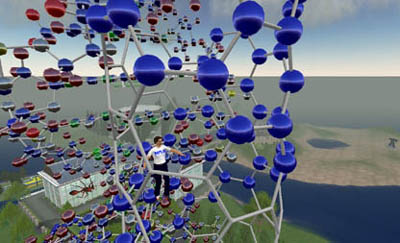
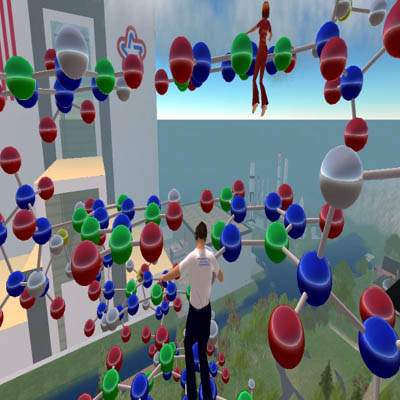
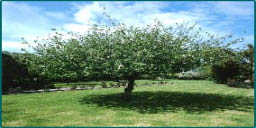
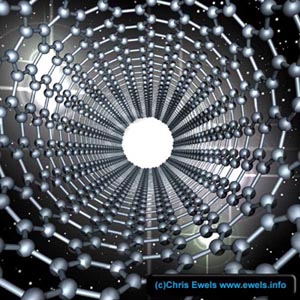
October 8th, 2007 at 11:26 am
Excellent article UGOTRADE, I can’t wait to visit this! How can we get a tour?
January 4th, 2008 at 1:31 pm
Come and visit, join: http://www.nanopaprika.eu the hungarian virtual network of nanoscience
January 13th, 2009 at 10:01 pm
A great read. I really enjoyed it!
David
March 25th, 2009 at 8:53 am
hi , i would like to know who posted this , who is the author of this article to reference it
thanks in advance
March 25th, 2009 at 11:31 am
Hi, I am the author – Tish Shute. For more info see the about page – links there.
March 26th, 2009 at 11:39 am
thanks Tish for your answer